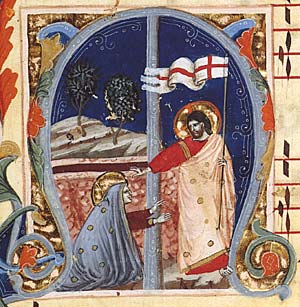 |
 |
Giotto and the Scrovegni Chapel |
 |
 |
 |
 |
 |
|
The first letter of the antiphonary echoing the
"Noli me tangere" scene
|
 |
Documentary sources
The first mention of Giotto as author of the wall paintings
in the Arena Chapel - a fact that has never been disputed - dates from
1312 -1313. It comes from a well-known passage in the Compilatio Chronologica
by Riccobaldo da Ferrara: "Joctus pictor eximius florentinus agnoscitur.
Qualis in arte fuerit testantur opera facta per eum in ecclesiis minorum
Assisii Arimini Padue et in ecclesia Arene Padue".
There is also another mention of the Giotto cycle just a few years later
(1313) in the Documenti d'amore by Francesco da Barberino: "[…]
unde ividiosuis invidia comburitur intus et extra hanc Padue in Arena
optime pinxit Giottus". The work must have been finished several
years previously, at least according to current expert opinion. This view
is based not only on observations of a critical nature but also on the
fact that there are several antiphonaries in Padua cathedral containing
miniatures which clearly echo the paintings in the Giotto cycle depicting
the same scenes. The miniatures are thought to have been produced before
1306 and this therefore represents the limiting date by which the frescoes
in the Arena Chapel must have been finished, especially since two of the
paintings taken as models, the Grieving over Christ's body and Noli me
tangere, can only have been painted when the whole project was coming
to an end, since they are located on the lowest register.
While it is possible to estimate that the project was completed by 1305,
or at any rate not after 1306, no certain date has come down enabling
us to know exactly when Giotto started
work in the Chapel. We do not know the date or even the year when
he arrived in Padua; on the other hand, such information would not be
particularly useful since he may not have been invited by the Scrovegnis,
but more probably by the Franciscans of St. Anthony. Judging from the
surviving
fragments in their church, we cannot be sure that they are by Giotto;
all we can say is that one fragment depicting ecclesiastical figures might
be from his studio and is probably dated around 1310-1320. All in all,
there are still many questions to
be resolved.
|












